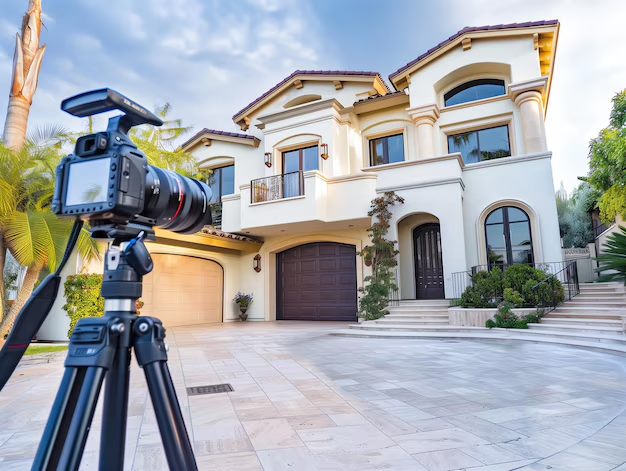Real estate photography is an essential part of the property-buying process. Whether you’re a real estate agent, homeowner, or investor, high-quality photos can make a world of difference in how quickly and profitably a property sells. But behind those captivating images, there are many fascinating facts that shape the world of real estate photography. Let’s dive into 10 interesting things about this crucial aspect of the real estate industry.
1. First Impressions Matter More Than You Think
Studies show that 90% of home buyers begin their property search online, with the photos being the first thing they notice. The first impression a buyer gets from a listing is often based solely on its visuals, so real estate photography is critical. Homes with professional photos can sell 32% faster than those with amateur shots. Good lighting, proper staging, and attention to detail can all make or break a sale.
2. It’s Not Just About Taking Pretty Pictures
Real estate photography is far more technical than many people realize. It involves mastering lighting, angles, composition, and depth. Often, photographers use specialized techniques such as HDR (high dynamic range) photography, which blends several shots of the same scene taken at different exposure levels. This allows the photographer to capture both the bright areas and darker shadows, making the final image appear more balanced and lifelike.
3. Virtual Staging Has Taken Over
While physical staging is still popular, virtual staging has become an incredibly popular trend in real estate photography. By digitally placing furniture and décor into empty rooms, virtual staging saves money and time while creating a more appealing vision for potential buyers. It’s also eco-friendly, as it eliminates the need to move bulky furniture from one location to another.
4. Aerial Photography Has Changed the Game
With the rise of drones, aerial photography has become an invaluable tool in real estate photography. A bird’s-eye view of a property can show off its surroundings, size, and unique features in a way that traditional ground-level shots can’t. Drones provide an entirely new perspective that appeals to both buyers and agents, highlighting the property’s outdoor amenities, proximity to schools or parks, and the neighborhood’s general layout.
5. The Golden Hour Is Essential
In the world of photography, there’s something magical about the “golden hour”—the period shortly after sunrise and just before sunset. During this time, the natural light is softer, warmer, and less harsh, resulting in stunning, glowing images. Many real estate photographers aim to capture shots during this time because it helps highlight the property’s best features and gives it a welcoming, cozy vibe.
6. The Camera Isn’t the Only Tool
While a good camera is essential, real estate photographers also rely on other specialized equipment. Tripods are necessary for steady shots, especially when doing wide-angle shots or HDR photography. Lenses also play a significant role, with wide-angle lenses often used to make rooms appear more spacious. Additionally, lighting equipment, reflectors, and even post-processing software like Adobe Lightroom or Photoshop are crucial for getting the perfect shot.
7. Buyers Are Looking for Specific Features
Real estate photos aren’t just about showcasing the overall beauty of a property; they also need to highlight certain key features. Kitchen islands, large living rooms, luxurious bathrooms, and spacious backyards are among the most sought-after features. Photographers know to focus on these spaces to make sure buyers see them in the best possible light. Proper composition and framing can help emphasize these attributes effectively.
8. The Importance of Image Quality
Image quality is paramount in real estate photography. Listings with high-resolution images look more professional and trustworthy, which attracts more buyers. On the other hand, low-quality, blurry, or poorly lit photos can turn potential buyers away. A study found that listings with high-quality images generate 118% more online views than those with low-quality images. Real estate agents and sellers should always prioritize sharp, clear images that display the property in its best light.
9. First-Click Photos Are Often the Most Important
The first image in a listing is critical—buyers often form an opinion about a property within seconds of seeing the first photo. This image needs to grab attention and showcase the home’s best angle. A good photographer will use a mix of wide-angle shots, staging, and lighting techniques to ensure that the first impression is strong enough to make a buyer want to look at the rest of the property.
10. The Power of Editing
Post-production plays a huge role in real estate photography. While professional photographers aim to capture a property’s true essence, editing can make all the difference. This includes adjusting exposure, contrast, and color temperature to ensure that the final photos appear vibrant and realistic. Some photographers even remove distractions like power lines or clutter from the images to create a cleaner, more inviting atmosphere.
Final Thoughts
Real estate photography is an art form that blends technical skills with creative vision. The impact of great photos can be seen not only in the speed of a property’s sale but also in its final selling price. Whether through HDR techniques, drone shots, or virtual staging, the world of real estate photography is constantly evolving. So, next time you see a beautiful listing photo, remember that a lot of work goes into creating that perfect shot!
By embracing these fascinating facts, real estate agents and sellers can harness the power of professional photography to enhance their listings and reach a wider audience. After all, in the world of real estate, a picture is worth much more than a thousand words—it’s often worth thousands of dollars!


2 Responses
Very good
Good